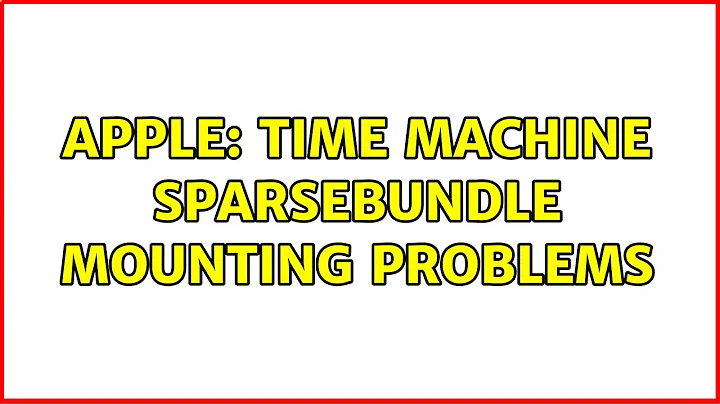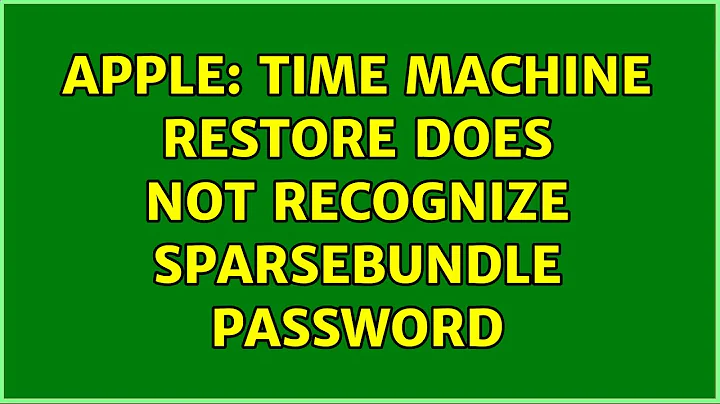Time machine not recognizing sparsebundle
Time Machine backups are a nightmare on NAS, however this is what I did with a NetGear Stora:
In Finder -> Go -> Connect to server.
enter your NAS address including username and password, like this:
smb://username:[email protected]/ *or whatever your volume's IP is.*
then select to mount the volume of where you want to keep your sparse bundle image.
Now open the disk utility, and create a sparse bundle with the following settings:
- Name: Backup (or whatever)
- Size: 300GB (or whatever)
- Format: Mac OS Extended (Journaled)
- Encryption: none
- Partition: No partition map
- Image Format: sparse bundle disk image
- Save As: yourcomputername.sparsebundle (e.g.: Toms-MacBook-Pro.sparsebundle)
After you've done all that copy it to your backup volume and open Time Machine's preferences
Click on Select Disk and choose the volume that you want to backup to.
======
A couple of suggestions:
Follow this screencast that i made to auto mount your volume on start up http://www.youtube.com/watch?v=2vhcmEd0Y8o
Do not upgrade to OSX Lion when it comes out, since at least for my Netgear's Stora the Time Machine did not work and i ended up buying a Time Capsule, check first on the ReadyNAS forums.
Related videos on Youtube
Dominic
Updated on September 18, 2022Comments
-
Dominic over 1 year
I have the following code to work out the MKCoordinateRegion to display the map including two defined points. The problem is it doesn't work when the longitude goes over 180 or -180 degrees.
CLLocationCoordinate2D tempPoint1 = CLLocationCoordinate2DMake(startLat,startLong); CLLocationCoordinate2D tempPoint2 = CLLocationCoordinate2DMake(nextLat,nextLong); if (lineType == 1) { [self createGreatCircleMKPolylineFromPoint: tempPoint1 toPoint: tempPoint2 forMapView:mapView]; } else { CLLocationCoordinate2D *coords = malloc(sizeof(CLLocationCoordinate2D) * 2); coords[0] = tempPoint1; coords[1] = tempPoint2; MKPolyline *polyline = [MKPolyline polylineWithCoordinates:coords count:2]; free(coords); [mapView addOverlay:polyline]; } double lon1 = tempPoint1.longitude * M_PI / 180; double lon2 = tempPoint2.longitude * M_PI / 180; double lat1 = tempPoint1.latitude * M_PI / 180; double lat2 = tempPoint2.latitude * M_PI / 180; double dLon = lon2 - lon1; double x = cos(lat2) * cos(dLon); double y = cos(lat2) * sin(dLon); double lat3 = atan2( sin(lat1) + sin(lat2), sqrt((cos(lat1) + x) * (cos(lat1) + x) + y * y) ); double lon3 = lon1 + atan2(y, cos(lat1) + x); CLLocationCoordinate2D center; center.latitude = lat3 * 180 / M_PI; center.longitude = lon3 * 180 / M_PI; MKCoordinateSpan locationSpan; locationSpan.latitudeDelta = fabs(tempPoint1.latitude - tempPoint2.latitude) * 1.2; locationSpan.longitudeDelta = fabs(tempPoint1.longitude - tempPoint2.longitude) * 1.2; MKCoordinateRegion region = {center, locationSpan}; [mapView setRegion:region];Any ideas how I could alter this code to make sure it can handle the startLong being positive i.e. 174 and the nextLong being negative i.e. -127, and vice versa
-
HikeMike almost 13 yearsIt's unsupported by Apple and Snow Leopard didn't exist when that tutorial was written. Why do you expect it to still work after a major upgrade of the OS?
-
-
 Scott almost 13 yearsThat used to be the case, but now (at a guess, since Snow Leopard)
Scott almost 13 yearsThat used to be the case, but now (at a guess, since Snow Leopard)MachineName.sparsebundleis correct. -
Dominic almost 9 yearsBut they are not from 0 to 360 degrees. They are from -180 to 180
-
Nicolas Buquet almost 9 yearsIt's the same modulo 360. Substract 180 at the end and you will have values between -180 and 180.




